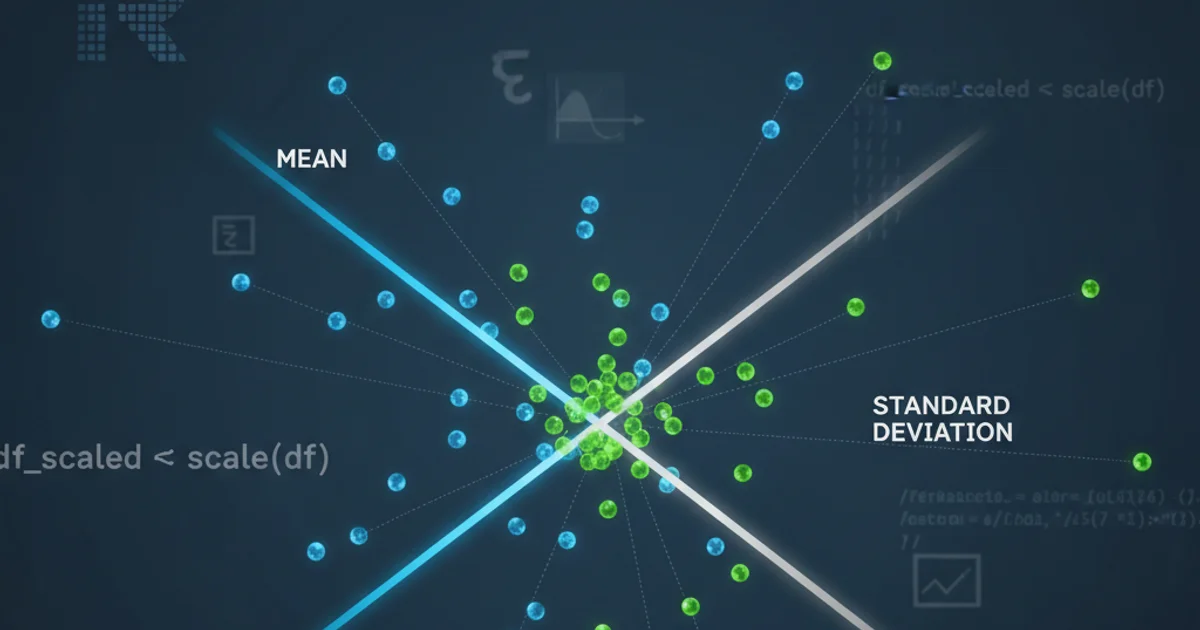Understanding `scale` in R
scale in r with practical examples, diagrams, and best practices. Covers r, scale, transformation development techniques with visual explanations.Categories:
Understanding scale() in R: Normalization and Standardization for Data Analysis

Explore the scale() function in R, its parameters, and how it's used for data normalization and standardization. Learn to prepare your data for various statistical analyses and machine learning models.
In data analysis and machine learning, preparing your data is a crucial step. One common preparation technique is scaling, which involves transforming numerical features to a standard range or distribution. In R, the scale() function is a powerful and convenient tool for this purpose. This article will delve into the scale() function, explaining its mechanics, parameters, and practical applications for both normalization and standardization.
What is scale() and Why Use It?
The scale() function in R is primarily used to center and/or scale the columns of a numeric matrix or data frame. This transformation is vital for several reasons:
- Equal Contribution: Many machine learning algorithms (e.g., K-Means, PCA, SVMs, neural networks) are sensitive to the scale of input features. Features with larger ranges might dominate the distance calculations or gradient descent updates, leading to biased results. Scaling ensures all features contribute equally.
- Improved Algorithm Performance: Scaling can help algorithms converge faster and perform better. For instance, gradient descent-based optimizers often work more efficiently when features are on a similar scale.
- Interpretability: Standardized data (mean 0, standard deviation 1) can sometimes be easier to interpret, as values represent the number of standard deviations away from the mean.
- Avoiding Numerical Instability: Extremely large or small values can sometimes lead to numerical instability in certain computations.
flowchart TD
A["Raw Data (e.g., `c(10, 20, 30)`)"] --> B{"`scale()` function"}
B --> C{"`center = TRUE`?"}
C -- Yes --> D["Subtract Mean (Centering)"]
C -- No --> E["Data is not centered"]
D --> F{"`scale = TRUE`?"}
E --> F
F -- Yes --> G["Divide by Standard Deviation (Scaling)"]
F -- No --> H["Data is not scaled"]
G --> I["Scaled Data (Mean 0, SD 1)"]
H --> J["Centered Data (Mean 0, Original SD)"]
I --> K["Output: Transformed Data"]
J --> KFlowchart illustrating the logic of the scale() function in R
Understanding center and scale Parameters
The scale() function has two main parameters that control its behavior: center and scale.
center: A logical value or a numeric vector. IfTRUE(default), the function subtracts the mean of each column from its values, effectively centering the data around zero. IfFALSE, no centering is performed. If a numeric vector is provided, these values are subtracted from the corresponding columns.scale: A logical value or a numeric vector. IfTRUE(default), the centered values are divided by their respective standard deviations (ifcenter = TRUE) or by their root-mean-square (ifcenter = FALSE). This results in a standard deviation of 1 for each column. IfFALSE, no scaling is performed. If a numeric vector is provided, these values are used to divide the corresponding columns.
center = TRUE and scale = TRUE (the default behavior), scale() performs standardization (also known as Z-score normalization). This transforms data to have a mean of 0 and a standard deviation of 1.Practical Examples of scale() in R
Let's look at various ways to use scale() with different parameter combinations.
# Create a sample data matrix
data_matrix <- matrix(c(
10, 20, 30,
15, 25, 35,
5, 15, 25,
20, 30, 40
), ncol = 3, byrow = TRUE)
colnames(data_matrix) <- c("FeatureA", "FeatureB", "FeatureC")
print("Original Data:")
print(data_matrix)
# 1. Default behavior: Standardization (center = TRUE, scale = TRUE)
scaled_data_default <- scale(data_matrix)
print("\nStandardized Data (Mean 0, SD 1):")
print(scaled_data_default)
# Verify mean and standard deviation for a column
print(paste("Mean of FeatureA (scaled):", mean(scaled_data_default[, "FeatureA"])))
print(paste("SD of FeatureA (scaled):", sd(scaled_data_default[, "FeatureA"])))
# 2. Centering only (center = TRUE, scale = FALSE)
centered_data <- scale(data_matrix, center = TRUE, scale = FALSE)
print("\nCentered Data (Mean 0, Original SD):")
print(centered_data)
# Verify mean for a column
print(paste("Mean of FeatureA (centered):", mean(centered_data[, "FeatureA"])))
print(paste("SD of FeatureA (centered):", sd(centered_data[, "FeatureA"])))
# 3. Scaling only (center = FALSE, scale = TRUE) - less common
# This divides by the root-mean-square (RMS) if not centered
scaled_only_data <- scale(data_matrix, center = FALSE, scale = TRUE)
print("\nScaled Only Data (Divided by RMS):")
print(scaled_only_data)
# 4. Custom centering and scaling values
custom_center <- c(12.5, 22.5, 32.5) # Example custom means
custom_scale <- c(5, 5, 5) # Example custom standard deviations
custom_scaled_data <- scale(data_matrix, center = custom_center, scale = custom_scale)
print("\nCustom Centered and Scaled Data:")
print(custom_scaled_data)
Demonstrating scale() with different center and scale parameter combinations.
scale() to a data.frame, it will automatically apply the transformation column-wise to all numeric columns. Non-numeric columns will be ignored or cause an error if data.frame contains non-numeric columns and scale is applied directly.Using scale() for Heatmaps and Visualization
Scaling is particularly useful when creating heatmaps, especially when different features have vastly different ranges. Scaling ensures that no single feature dominates the color intensity, allowing for better visualization of patterns and relationships across all features. For instance, if you have gene expression data where some genes have expression levels in the thousands and others in the tens, scaling them before plotting a heatmap will make the variations in lower-expressed genes visible.
# Install and load pheatmap if you don't have it
# install.packages("pheatmap")
library(pheatmap)
# Create a sample data matrix with varying scales
set.seed(123)
heatmap_data <- matrix(rnorm(50, mean = 100, sd = 10), ncol = 5)
heatmap_data <- cbind(heatmap_data, rnorm(10, mean = 5, sd = 1))
heatmap_data <- cbind(heatmap_data, runif(10, min = 0.1, max = 0.5))
colnames(heatmap_data) <- paste0("Gene", 1:7)
rownames(heatmap_data) <- paste0("Sample", 1:10)
print("Original Heatmap Data (first 3 rows):")
print(head(heatmap_data, 3))
# Heatmap without scaling (default pheatmap behavior often scales, but let's be explicit)
# pheatmap(heatmap_data, main = "Heatmap without explicit scaling")
# Heatmap with data scaled using `scale()`
scaled_heatmap_data <- scale(heatmap_data)
print("\nScaled Heatmap Data (first 3 rows):")
print(head(scaled_heatmap_data, 3))
pheatmap(scaled_heatmap_data, main = "Heatmap with `scale()` (Z-score)")
Applying scale() before generating a heatmap for better visualization.